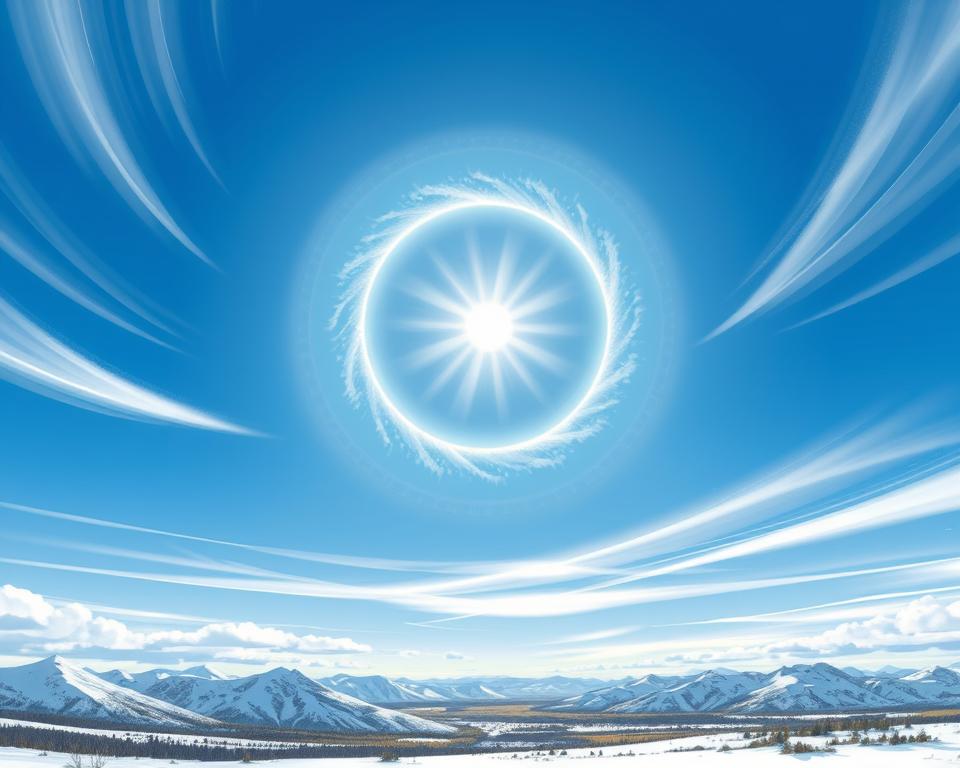Table of Contents
Atmospheric Halos are among the most enchanting optical phenomena to grace our skies, captivating the unwary gazer with celestial arcs that both mystify and dazzle. These rings and arcs aren’t just eyecatchers; they are fascinating displays of light bending and bouncing off ice crystals, high in the cirrus or cirrostratus clouds within the upper troposphere. Glimpsing a halo twirling around the sun or moon might seem otherworldly, but there’s much more scientific substance to these beautiful sights than meets the eye.
One may not often ponder about the lofty heights, 5 to 10 km above our heads, where these crystals dwell and conspire with light to create such luminous artwork. It’s here in these ice-crystal galleries where weather optics come to life, unveiling the secrets of light that create the well-known 22° halos, light pillars, and even the elusive Bottlinger’s ring. But did you know that these stunning arrangements of light also tell tales of oncoming weather, foretelling rain within a day’s passage?
Australia’s skies, too, are no stranger to these meteorological spectacles, with high cirrus clouds often setting the scene for the 22° halo, a familiar friend to sky watchers. Yet, while these phenomena are splashed across the canvas of our atmosphere, capturing them through photography poses its own challenges, with precautions necessary to protect oneself and one’s camera from the blazing sun.
Folklore and weather lore have long intertwined with the occurrence of atmospheric halos, weaving stories and predictions into the very fabric of human history, as far back as records go. It’s this interplay between the realms of science and myth that make halos not just optical phenomena, but cultural artifacts that have withstood the test of time.
Whether one regards these halos as mere weather optics or emblems of the heavens, their ability to stir up intrigue and wonder remains undiminished. As we stand amid the sweeping landscapes of Australia, it’s hard not to reflect on the complex ballet of ice crystals and light particles that enable us to witness such an awe-inspiring aspect of our natural world.
The Mystifying Science Behind Atmospheric Halos
Atmospheric halos are a fascinating weather phenomenon, predominantly occurring when light interacts with ice crystals scattered across the Earth’s atmosphere. Understanding these captivating displays requires a deep dive into the fields of atmospheric science and atmospheric optics. These halos are not just splendid visual spectacles; they are also critical to enhancing our comprehension of atmospheric phenomena through the lens of scientific inquiry.
Formation of Ice Crystals in Cirrus Clouds
Cirrus clouds, typically found at high altitudes, play a crucial role in the formation of atmospheric halos. These clouds are composed of ice crystals that foster the necessary conditions for light refraction. When sunlight or moonlight passes through these hexagonally-shaped crystals, it bends in unique patterns, due to the intricate alignment of the crystal facets. This bending of light, or light refraction, is what creates the stunning visual effects we see as halos around the sun or moon.
Properties of Light Refraction and Reflection
The science of light refraction and its interplay with atmospheric optics is central to understanding halo formations. Each ray of light, when refracted through different angles of ice crystals, contributes to the halo’s overall shape and size. Furthermore, reflection from these ice crystals adds glints or bright spots within the halo, enhancing its visibility and adding to its mysterious allure. Technological advancements such as spectrometers have been instrumental in deconstructing the refractive indices, helping scientists glean more accurate readings of halo phenomena.
Cultural and Historical Perspectives
Historically, halos have been steeped in cultural significance, often seen as omens or divine signs across various civilizations. The Greeks, including Aristotle himself, documented their appearances, integrating them into their philosophical and meteorological discussions. This amalgamation of atmospheric science and cultural history not only enrich their folklore but also enrich our understanding of how ancient societies interpreted natural phenomena. Modern science continues to build on these interpretations, providing a clearer picture of the intricate dance between light and ice in our atmosphere.
Overall, the mystique of atmospheric halos continues to be a rich field of study, inviting both professional scientists and amateur weather enthusiasts to explore and document this exquisite interplay of light, ice, and atmospheric conditions. The insights gained not only enhance our aesthetic appreciation of nature but also bolster our scientific knowledge in atmospheric optics.
Encountering the 22° Halo: A Common Optical Phenomenon
When discussing the spectacle of atmospheric optics, the 22° halo is undeniably the most commonly observed type, famed for its entrancing circle of light around the sun or moon. Stemming from the perfect light refraction through ice crystals, these halos present a radius about twice the width of an outstretched fist, a notably frequent visual treat compared to the more sporadic rainbow.

This remarkable phenomenon can be seen on average twice a week across various locations, from Europe to parts of the United States, underlining its status as the most common of such optical displays. The formation of a 22° halo involves a ring of milky-white light centered around a luminous body, primarily due to the semi-random orientation of ice crystals in the atmosphere, which act as prisms. This light bending is key to their creation, showcasing a spectrum that includes a faint rainbow with red on the inside moving to blue on the outside.
Efforts to observe these halos should be undertaken with care to shield the eyes from excessive glare, an important safety tip for both casual observers and photographers alike. For those keen to capture this natural marvel, using a wide-angle lens is often recommended to adequately encompass the halo’s expansive spread.
Apart from the alluring visual effect, halos are imbued with historical and mystical significance, often seen as omens or portents in cultural lore. This mysticism is particularly vivid in accounts of sun dogs, sun pillars, and lunar halos that also owe their existence to light refraction and reflection off ice crystals. Sun dogs, or parhelia, create a particularly breathtaking sight, displaying vibrant spots of light approximately 22 degrees distant from the halo on either side.
To explore more about these fascinating atmospheric optics, including variations like circumscribed halos, upper tangent arcs, and the rarity of light pillars, expert resources available both online and in literature provide a deep dive into how these phenomena not only decorate our skies but also enrich our understanding of light and atmosphere.
The natural allure and the complex science behind the 22° halo make it a quintessential subject for study and enjoyment among enthusiasts eager to understand or simply appreciate the beauty of light refraction phenomena in the atmosphere.
Unraveling the Less Common Halo Varieties
While the 22° halo might be the most witnessed celestial phenomenon across the skies, the world of atmospheric optics holds a rich catalogue of lesser-seen marvels. These include not only the elliptical Bottlinger’s Ring, noted for its fragility in visibility, but also vibrant arcs like circumzenithal and circumhorizontal arcs, and eye-catching phenomena like sun dogs and light pillars. Each represents a unique interplay of light and ice, manifesting under specific atmospheric conditions.
Bottlinger’s Ring and the Rarity of Elliptical Halos
Bottlinger’s Ring, a rare type of halo, requires a precise arrangement of ice crystals to form. Unlike the common circular halos formed by simple refraction through hexagonal ice crystals, elliptical halos like Bottlinger’s are presumed to arise from more eccentrically shaped ice formations. The delicate nature and rarity of these crystals contribute to the elliptical halo’s elusive visibility, making sightings an exceptional event for atmospheric optics enthusiasts.
Colourful Circumzenithal and Circumhorizontal Arcs
Distinguished by their intense vividness, the circumzenithal and circumhorizontal arcs are often perceived as upside-down rainbows. Their rarity is due to the specific angular positioning required from plate-shaped ice crystals. When the sun is positioned optimally in the sky, these crystals refract sunlight into a spectrum of colors, creating a stunning visual spectacle reminiscent of a rainbow but occurring much closer to the zenith.
Other Notable Halos: From Sun Dogs to Light Pillars
Sun dogs and light pillars illustrate other fascinating aspects of atmospheric optics. Sun dogs appear as brightly colored spots on either side of the sun, often part of a larger halo. These are caused by the refraction of light through hexagonal ice crystals, which act similar to prisms. On the other hand, light pillars emerge as vertical columns of light extending upward or downward from a light source. These are formed by the reflection of light off flat-ended ice crystals, typically seen during cold weather over urban landscapes at dawn or dusk.
Phenomenon |
Definition |
Visual Appearance |
|---|---|---|
Sun Dogs |
Colored patches of light caused by the refraction of sunlight through ice crystals. |
Small, radiant spots of white or reddish light observed approximately 22° to the left or right of the sun. |
Light Pillars |
Vertical beams of light extending from a light source, created by the reflection of lights off ice crystals. |
Subtle, elongate beams that can appear above or below a light source, often creating a surreal effect. |
Circumzenithal Arcs |
A brightly colored, curved band positioned near the zenith, occurring due to refracted sunlight through ice crystals. |
Resembling an upside-down rainbow, these arcs are typically vivid and positioned at high altitudes. |
These atmospheric phenomena not only enrich our understanding of the complex interactions within Earth’s atmosphere but also captivate those lucky enough to observe them. As advancements in technology continue, so too does our ability to document and study these rare optical manifestations, further expanding our comprehension of the natural world.
How Weather Lore and Halos Intersect
Understanding the intricate relationship between weather lore and atmospheric phenomena, such as halos, sheds light not only on ancient wisdom but also on the sophistication of modern atmospheric science. The rich tapestry of folklore intertwined with scientific principles offers a unique perspective on weather forecasting.
Weather Prediction and Halos in Folklore
Throughout history, cultures across the world have observed halos—bright circles of light around the Sun or Moon—as harbingers of weather change. Traditionally, these rings are viewed as predictors of rain or storms, a belief detailed in many folklore tales. For instance, a common saying that a halo around the Moon spells incoming rain has been passed down through generations. This lore is surprisingly supported by atmospheric science, which links the appearance of halos to the precursory conditions of storm fronts.
Halos result from the refraction of light through ice crystals in cirrus clouds, which often precede the frontal systems associated with inclement weather conditions.
Scientific Explanation Versus Myth
While folklore provides a narrative for atmospheric observations, modern weather forecasting utilises principles of atmospheric science to explain why these phenomena occur. The refractive index of ice crystals, at about 1.309, and the specific deviation angles ranging from 22° to 50° illustrate why halos are visible under certain conditions. These metrics have been vital in bolstering the scientific understanding beyond mere myth.
Additionally, phenomena detailed within weather lore, such as the Groundhog Day Tradition or observations of animal behaviour, correlate with scientific observations of environmental changes, demonstrating a blend of anecdotal and empirical evidence that enriches our overall understanding of meteorology.

Halo Type |
Appearance Conditions |
Folklore Belief |
Scientific Explanation |
|---|---|---|---|
Sun Halos |
Sky covered by cirrus or cirrostratus clouds |
Approach of storm fronts |
Light refraction through ice crystals at 22° |
Moon Halos |
Thin, high-altitude clouds at night |
Prediction of rain |
Moonlight refracting through ice crystals |
Red Sky at Morning |
Moisture particles in the air at dawn |
Storms from the west |
Scattering of light due to atmospheric particles |
In conclusion, the interplay between weather lore and atmospheric observations highlights the value of integrating cultural knowledge with scientific insights into weather forecasting. This supplementation of folklore with rigorous atmospheric science not only confirms ancient observations but also enriches the educational narrative surrounding meteorological phenomena.
Global Halo Sightings and Photographic Challenges
As an atmospheric spectacle captivating enthusiasts and professionals alike, atmospheric halos remain a marvel in the canon of optical phenomena. Taking a glance at the sheer variety of halos injected with the vibrancy of natural artistry, it’s evident that they’re not only exceptional weather phenomena but also a study in the complex dance of light and ice. The rarity of certain halo types confirms that their occurrence is as sporadic as it is stunning. An instance of this rarefied display was on May 29, 2014, in Laredo, Texas, where Araceli Cadena and Lizett Montiel documented a spectacular ensemble, interpreting the sky’s theatrics with photographic prowess. Unveiled were breathtaking circular halos, parhelic circles, along with infralateral arcs, offering a visual feast detailed on Atmospheric Optics dedicated to advancing our understanding of such phenomena.
Framing these celestial wonders poses its own litany of challenges, from guarding sensitive equipment against the sun’s assertive rays to circumnavigating the safety concerns associated with direct sunlight exposure. Yet, photographers persevere, aiming to capture the sharp inner edge and gossamer-like outer boundary that hallmark these rings of mystique. Notably, when the nocturnal counterpart graces the sky, observers often witness lunar halos lacking the solar spectrum’s vividity, compelling a deeper appreciation of atmospheric optics and the nuance of light interaction.
Each captured image contributes substantially to an eclectic global collage and scientific repository. The phenomenon is a convergence of serendipity and precision—the former in beholding such a spectacle, the latter in discerning the subtle nuances between similar formations. For instance, distinguishing the rare 44° sundog from the more familiar 46° halo requires an astute and educated eye. Through advanced understanding and ongoing contribution from weather enthusiasts, the known forms of halos have expanded exponentially, from approximately 20 in the early 19th century to an astonishing 119 today, as confirmed by researchers from Helsinki and Ural Federal Universities. This expansion of knowledge reflects the collective contributions made possible by the proliferation of camera-equipped mobile devices, facilitating further exploration into the ethereal world of atmospheric optics.
FAQ
Q: What are Atmospheric Halos?
A: Atmospheric Halos are spectacular optical phenomena consisting of rings or arcs around the Sun or Moon, caused by the interaction of light with ice crystals in the atmosphere. They can appear as coloured or white circles, arcs, or spots in the sky, often seen when light refracts through cirrus or cirrostratus clouds that contain these ice crystals.
Q: How do ice crystals form Atmospheric Halos?
A: Ice crystals form Atmospheric Halos through the processes of light refraction and reflection. They are typically found in cirrus clouds high in the upper troposphere or as ground-level diamond dust in cold weather. The ice crystals’ hexagonal structure causes light to bend and split into colours or reflect light, producing the halo effect.
Q: Why are Atmospheric Halos culturally and historically significant?
A: Atmospheric Halos have been observed and documented for centuries. They have been portrayed in artworks, such as the 22° halo in the Vädersolstavlan, and interpreted as omens or divine signs in various cultures. Notable figures including Aristotle have described halos, highlighting their long-standing fascination both scientifically and mythologically.
Q: What differentiates a 22° Halo from other optical phenomena?
A: The 22° Halo is distinct because it appears as a luminous circle with a 22-degree radius from the Sun or Moon. The ice crystals responsible for this type of halo are semi-randomly oriented, allowing it to cast a light ring with a darker interior. Unlike coronas, which are multicoloured and caused by water droplets, the 22° halo forms through light interaction with ice crystals and results in a ring rather than a full disc.
Q: What causes the rare Bottlinger’s Ring?
A: Bottlinger’s Ring is a rare elliptical halo caused by very specific and uncommonly shaped ice crystals found in the atmosphere. It’s incredibly faint and difficult to observe due to the necessity of precise conditions, including the alignment and presence of these infrequent ice crystal shapes.
Q: Why do Circumzenithal and Circumhorizontal Arcs display vivid colours?
A: Circumzenithal and Circumhorizontal Arcs are known for their brilliant, vivid colours, which occur due to the special orientation of flat, plate-shaped ice crystals. When sunlight enters these crystals at a particular angle, it is refracted similarly to a prism, creating concentrated bands of colours similar to those in a rainbow.
A: Sun Dogs and Light Pillars are part of the family of Atmospheric Halos but manifest in unique forms. Sun dogs arise when light refracts through hexagonal ice crystals at a specific angle, creating bright spots on either side of the Sun. Light pillars occur as vertical beams of light when flat, horizontally-oriented ice crystals reflect light from a low Sun, moon, or artificial light sources back towards the observer.
Q: Can Atmospheric Halos predict the weather?
A: Yes, according to weather lore, the appearance of a halo can suggest an impending weather change, such as rain. This is supported by science, as cirrus clouds that typically cause halos can be forerunners to storm systems due to their high-altitude formations ahead of frontal systems.
Q: What scientific explanations dispel mythical interpretations of halos?
A: Advancements in atmospheric science have elucidated the physical processes behind halo formation, such as the specific roles of light refraction and reflection by ice crystals. These scientific insights explain halos as natural phenomena rather than the mythical or divine interpretations presented in folklore.
Q: What are challenges associated with photographing Atmospheric Halos?
A: Photographing Atmospheric Halos, especially solar halos, can be challenging due to the brightness of the source and the potential harm to both the camera sensors and the photographer’s eyes. Proper techniques and filters are necessary to capture the halos without damaging equipment or compromising the image’s integrity. The transient and variable nature of halos also means photographers must be ready to capture the moment quickly.
Source Links
- Halo (optical phenomenon)
- Explainer: what are halos? – Social Media Blog
- What makes a halo around the sun or moon?
- Atmospheric Halos
- Articles About Atmospheric Science, Meteorology, and Climatology
- Observing Halos – Getting started
- Frequent Halos
- How to See Halos, Sun Dogs and Other Delights of the Daytime Sky
- For the first time, scientists have systematized all the halos discovered over thousands of years of observations
- Scientists Have Systematized All the Halos Discovered over Thousands of Years
- 22° halo
- Dancing in the Rain: The Intriguing Science and Culture of Weather Folklore
- No title found
- OPOD – Balloon Meet Halo Display
- Scientists have systematized all the halos discovered over thousands of years of observations


